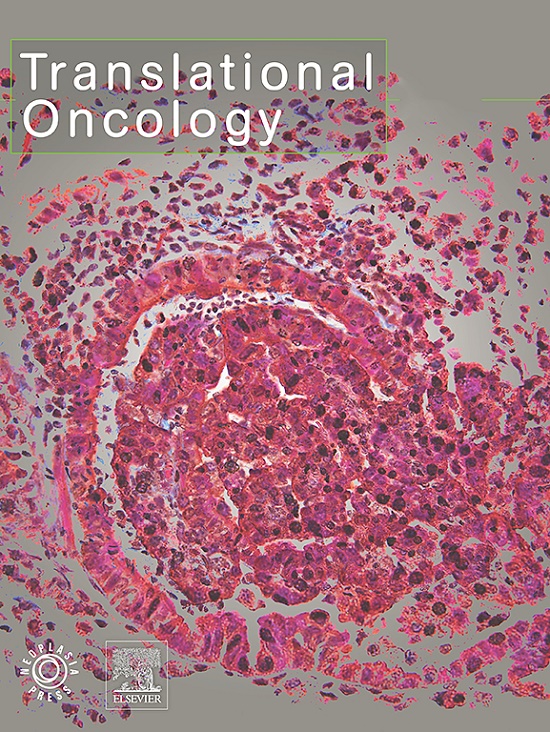将 S100A8/A9 和中性粒细胞作为免疫检查点抑制剂治疗的转移性黑色素瘤患者的预后标志物进行评估。
IF 5
2区 医学
Q2 Medicine
引用次数: 0
摘要
免疫检查点抑制剂(ICIs)已经彻底改变了黑色素瘤的治疗,然而大约一半的患者对这些疗法没有反应。确定预后生物标志物对治疗决策至关重要。我们的回顾性研究评估了液体活检和肿瘤组织分析的两种潜在生物标志物:危险相关分子模式(DAMP) S100A8/A9及其来源中性粒细胞。在43例未切除的转移性III/IV期黑色素瘤患者中,在ICI治疗前和治疗期间血清S100A8/A9和中性粒细胞水平升高与预后较差相关。此外,在113例黑色素瘤患者中,肿瘤微环境(TME)中的中性粒细胞表达与复发和生存率降低有关。测量S100A8/A9和中性粒细胞可以通过预测临床结果受损和对ICIs无反应来加强免疫治疗监测。血清S100A8/A9水平和中性粒细胞计数在基线(T0)和治疗期间(T3)与降低的无进展生存期(PFS)相关。T0和T3时S100A8/A9水平升高对总生存期(OS)产生负面影响。值得注意的是,中性粒细胞浸润在原发性黑色素瘤中比在痣和转移瘤中更普遍,并且它在原发性黑色素瘤中的存在与较差的生存率有关。S100A8/A9血清水平、中性粒细胞计数和肿瘤相关中性粒细胞浸润是预测接受ICIs的黑色素瘤患者治疗反应和临床结果的有希望的生物标志物。意义:这些发现强调了黑色素瘤研究中可靠的生物标志物的迫切需要,特别是用于预测免疫检查点抑制剂(ICIs)的反应。确定S100A8/A9水平和中性粒细胞浸润作为治疗结果的潜在指标,为个性化治疗决策提供了有价值的见解。通过加强监测和预后评估,这些生物标志物有助于改进治疗策略,最终改善患者护理和预后。这项研究弥补了理解黑色素瘤反应机制的空白,并强调了进一步研究免疫相关标志物的途径,促进了黑色素瘤患者精准医学的进步。本文章由计算机程序翻译,如有差异,请以英文原文为准。

Evaluation of S100A8/A9 and neutrophils as prognostic markers in metastatic melanoma patients under immune-checkpoint inhibition
Immune-checkpoint inhibitors (ICIs) have revolutionized melanoma treatment, yet approximately half of patients do not respond to these therapies. Identifying prognostic biomarkers is crucial for treatment decisions. Our retrospective study assessed liquid biopsies and tumor tissue analyses for two potential biomarkers: danger-associated molecular pattern (DAMP) S100A8/A9 and its source, neutrophils. In 43 metastatic unresected stage III/IV melanoma patients, elevated serum levels of S100A8/A9 and neutrophils before and during ICI treatment correlated with worse outcomes. Furthermore, in 113 melanoma patients, neutrophil expression in the tumor microenvironment (TME) was associated with relapse and reduced survival. Measuring S100A8/A9 and neutrophils could enhance immunotherapy monitoring by predicting impaired clinical outcomes and non-response to ICIs. Serum S100A8/A9 levels and neutrophil counts at baseline (T0) and during treatment (T3) correlated with reduced progression-free survival (PFS). Elevated S100A8/A9 levels at T0 and T3 negatively impacted overall survival (OS). Notably, neutrophil infiltration was more prevalent in primary melanomas than in nevi and metastases, and its presence in primary melanomas was linked to poorer survival. S100A8/A9 serum levels, neutrophil counts, and tumor-associated neutrophil infiltration represent promising biomarkers for predicting treatment response and clinical outcomes in melanoma patients receiving ICIs.
Significance
These findings underscore the critical need for reliable biomarkers in melanoma research, particularly for predicting responses to immune-checkpoint inhibitors (ICIs). Identifying S100A8/A9 levels and neutrophil infiltration as potential indicators of treatment outcomes offers valuable insights for personalized therapy decisions. By enhancing monitoring and prognosis assessment, these biomarkers contribute to refining treatment strategies, ultimately improving patient care and outcomes. This research bridges gaps in understanding melanoma response mechanisms and highlights avenues for further investigation into immune-related markers, fostering advancements in precision medicine for melanoma patients.
求助全文
通过发布文献求助,成功后即可免费获取论文全文。
去求助
来源期刊

Translational Oncology
ONCOLOGY-
CiteScore
8.40
自引率
2.00%
发文量
314
审稿时长
54 days
期刊介绍:
Translational Oncology publishes the results of novel research investigations which bridge the laboratory and clinical settings including risk assessment, cellular and molecular characterization, prevention, detection, diagnosis and treatment of human cancers with the overall goal of improving the clinical care of oncology patients. Translational Oncology will publish laboratory studies of novel therapeutic interventions as well as clinical trials which evaluate new treatment paradigms for cancer. Peer reviewed manuscript types include Original Reports, Reviews and Editorials.
 求助内容:
求助内容: 应助结果提醒方式:
应助结果提醒方式:


